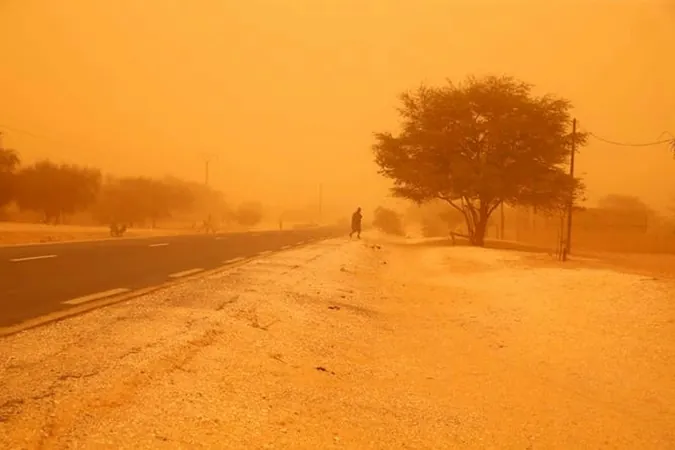
The Dangers of Harmattan: How West Africa’s Dusty Winds Spread Disease and Affect Health
2025-03-31
Author: Yu
Every year, between December and April, West Africa becomes shrouded in the Harmattan—a dry, cool wind rich in dust—and it’s more than just a weather phenomenon. Named after the Ghanaian word "haramata," this wind originates from the high-pressure systems over the Sahara, pushing down dry air from the north and transforming the climate as it sweeps across the region.
The Harmattan is not only responsible for reduced visibility and parched landscapes; it poses significant health risks to the populations in its path. Our research highlights how this wind not only affects human health but also agriculture and ecosystems, creating a ripple effect of challenges in West Africa.
What Causes the Harmattan?
During the boreal winter months (from October to March), the atmospheric patterns shift southward, causing the inter-tropical convergence zone—the area where moist southern winds meet the dry northern gusts—to migrate. This transition allows the Harmattan's influence to envelop nearly all of West Africa, particularly between December and late March.
The formation of the Harmattan is driven by significant differences in atmospheric pressure. To the north, a high-pressure system forces down dry air, while lower-pressure zones near the equator frequently spawn storms. This contrast creates steady winds that persist throughout the tropical regions, known as the trade winds.
How Harmattan Dries Out the Region
The Harmattan carries air masses from high altitudes, which dry out as they descend. Traveling through arid regions like the Sahara and Sahel, the wind remains desiccated, leading to dramatically dry conditions in affected areas. This phenomenon contrasts sharply with the rainy season, which is characterized by moist southeasterly monsoon winds.
During the months of peak Harmattan, particularly March and April, areas affected see stark temperature variations, with unseasonably cool nights followed by extreme heat. This creates a stable atmospheric layer at night, limiting the vertical movement of air and intensifying surface winds—especially dangerous in regions like the Bodélé Depression, known for its enormous dust production.
Dire Health Consequences
The implications of the Harmattan on public health are alarming. The dust-laden winds carry not just particulate matter but also microbes and parasites, leading to a range of health issues. Studies have shown correlations between elevated dust levels during the Harmattan and increased respiratory infections, such as bronchitis, pneumonia, and asthma.
Worse, the Harmattan has been linked to the spread of serious diseases. It facilitates not just common influenza outbreaks but also the proliferation of strains of Mycobacterium tuberculosis, which causes tuberculosis, as well as meningococci leading to meningitis—a common threat particularly in Sahelian nations. Research indicates that the increased dust levels have resulted in a staggering 24% rise in infant mortality rates, highlighting the urgent need for action.
Environmental and Agricultural Impacts
The dust storms also wreak havoc on local ecosystems, accelerating soil erosion and increasing evaporation of surface water. The implications extend to agriculture, with crops suffering from the negative impact of dust deposits. Moreover, aviation safety is compromised due to reduced visibility, and solar energy efficiency diminishes as dust coats photovoltaic panels.
Preparing for the Harmattan
Efforts to mitigate the risks associated with Harmattan winds have included extensive research and monitoring campaigns. Initiatives led by organizations such as the European Copernicus programme aim to enhance our understanding of dust patterns and their health impacts.
As the Harmattan season concludes in April, air quality declines, exacerbated by rising temperatures that contribute to respiratory issues. This underscores the necessity for accurate weather predictions and early warning systems to protect vulnerable populations.
To combat the health threats posed by the Harmattan, individuals are encouraged to take precautionary measures like using masks, applying saline solutions to keep airways moist, and receiving vaccinations where possible. Furthermore, enhancing air quality monitoring and establishing robust observation networks across West Africa are imperative, particularly in urban areas, where pollution exacerbates the hazards brought on by Harmattan winds.
In Conclusion
The Harmattan is a powerful natural force, but its dangers cannot be understated. With climate change and environmental degradation at the forefront of global challenges, proactive measures must be taken to safeguard the health of communities throughout West Africa. This long-standing wind not only carries dust but also the chilling reality of disease, demanding our immediate attention and action.


 Brasil (PT)
Brasil (PT)
 Canada (EN)
Canada (EN)
 Chile (ES)
Chile (ES)
 Česko (CS)
Česko (CS)
 대한민국 (KO)
대한민국 (KO)
 España (ES)
España (ES)
 France (FR)
France (FR)
 Hong Kong (EN)
Hong Kong (EN)
 Italia (IT)
Italia (IT)
 日本 (JA)
日本 (JA)
 Magyarország (HU)
Magyarország (HU)
 Norge (NO)
Norge (NO)
 Polska (PL)
Polska (PL)
 Schweiz (DE)
Schweiz (DE)
 Singapore (EN)
Singapore (EN)
 Sverige (SV)
Sverige (SV)
 Suomi (FI)
Suomi (FI)
 Türkiye (TR)
Türkiye (TR)
 الإمارات العربية المتحدة (AR)
الإمارات العربية المتحدة (AR)